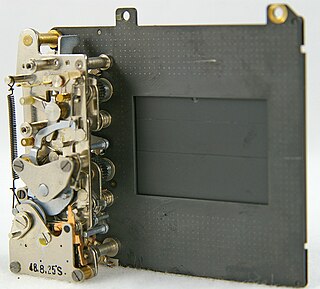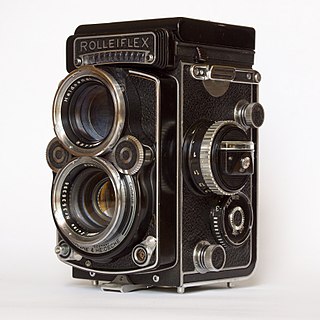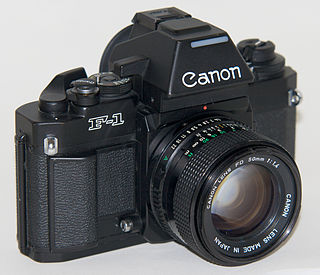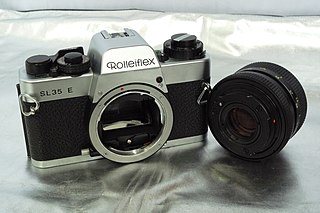
A single-lens reflex camera (SLR) is a camera that typically uses a mirror and prism system that permits the photographer to view through the lens and see exactly what will be captured. With twin lens reflex and rangefinder cameras, the viewed image could be significantly different from the final image. When the shutter button is pressed on most SLRs, the mirror flips out of the light path, allowing light to pass through to the light receptor and the image to be captured.

A twin-lens reflex camera (TLR) is a type of camera with two objective lenses of the same focal length. One of the lenses is the photographic objective or "taking lens", while the other is used for the viewfinder system, which is usually viewed from above at waist level.

In camera design, a focal-plane shutter (FPS) is a type of photographic shutter that is positioned immediately in front of the focal plane of the camera, that is, right in front of the photographic film or image sensor.

Rollei was a German manufacturer of optical instruments founded in 1920 by Paul Franke and Reinhold Heidecke in Braunschweig, Lower Saxony, and maker of the Rolleiflex and Rolleicord series of cameras. Later products included specialty and nostalgic type films for the photo hobbyist market.

Rolleiflex is the name of a long-running and diverse line of high-end cameras originally made by the German company Franke & Heidecke, and later Rollei-Werke.

The Canon New F-1 replaced the F-1n as Canon's top-of-the-line 35mm single-lens reflex camera in September 1981. Like the earlier models, the New F-1 takes FD-mount lenses. Although no date has ever been confirmed, it is thought that the last New F-1 was made in 1992. It was officially discontinued in 1994, and factory support ended in 2004.
The Olympus OM System was a line of 35mm single-lens reflex cameras, lenses and accessories sold by Olympus between 1972 and 2002. The system was introduced by Olympus in 1972. The range was designed by Yoshihisa Maitani, chief designer for Olympus, and his staff; OM stands for Olympus Maitani.

The Rolleiflex SL35 is a range of SLR cameras manufactured and sold by the German camera maker Rollei from 1970 to 1982. This range of cameras uses 35mm film. The camera bodies were initially made in Germany. After Zeiss Ikon discontinued camera production, Rollei acquired the Voigtländer brand and camera designs in 1972, and began producing a second generation of SLR cameras in Singapore starting from 1976. Some of those second-generation cameras were rebranded and marketed as Voigtländer VSL.

The history of the single-lens reflex camera (SLR) begins with the use of a reflex mirror in a camera obscura described in 1676, but it took a long time for the design to succeed for photographic cameras. The first patent was granted in 1861, and the first cameras were produced in 1884, but while elegantly simple in concept, they were very complex in practice. One by one these complexities were overcome as optical and mechanical technology advanced, and in the 1960s the SLR camera became the preferred design for many high-end camera formats.

The Rolleiflex SL66 is a line of medium format single lens reflex cameras made by Rollei, in regular production starting from 1966 until Rollei's bankruptcy in 1982. The SL66 represented a change in direction for Rollei, which until that time had focused almost exclusively on its popular twin lens reflex cameras, the Rolleiflex and Rolleicord.

The Contaflex series is a family of 35mm Single-lens reflex cameras (SLR) equipped with a leaf shutter, produced by Zeiss Ikon in the 1950s and 1960s. The name was first used by Zeiss Ikon in 1935 for a 35mm Twin-lens reflex camera, the Contaflex TLR; for the earlier TLR, the -flex suffix referred to the integral reflex mirror for the viewfinder. The first SLR models, the Contaflex I and II have fixed lenses, while the later models have interchangeable lenses; eventually the Contaflexes became a camera system with a wide variety of accessories.

Heinz Waaske was a German camera designer, notably father of the Rollei 35.

The Bessamatic and Ultramatic were lines of 35mm SLR cameras made by Voigtländer in the 1960s, featuring a selenium meter. It uses a leaf shutter, similar to competing SLR cameras manufactured by Kodak and Zeiss Ikon in Germany, rather than the focal plane shutter almost universally adopted by Japanese SLRs such as the contemporary Nikon F and Pentax Spotmatic. The Ultramatic was released in 1963, which used the same lens mount and added a shutter-priority autoexposure mode.

The Minolta X-1 was the professional model in the Minolta SR-mount line of single-lens reflex cameras (SLR), released in 1972 after ten years of development, which was the first X-series camera in the Minolta SLR system; prior to the X-1, specific Minolta SLR models were branded SR-T, and afterward, they included X in the name. The X-1 was the first SLR to combine an electronically-controlled shutter with interchangeable viewfinders.

Contarex is a line of 35mm single lens reflex cameras (SLRs) made by Zeiss Ikon. It was first presented at Photokina in 1958 and initially scheduled for delivery in the spring of 1959, but it was not made generally available in the United States until March 1960. The first model is popularly known as the Contarex I, the Bullseye, or the Cyclops, after the prominent light meter window above the lens, in front of the pentaprism. The camera was aimed at the high-end and professional markets; in 1961, the retail price was $499.

The Quick Bayonet Mount (QBM) is the bayonet mount system for the range of interchangeable lenses fitted to 135 film cameras built by Rollei in Germany and Singapore from 1970 through 1990, including the Rolleiflex SL35, Rolleiflex SL2000F, and Voigtländer VSL series. Lens brands sold with QBM included Carl Zeiss, Rolleinar, Schneider, and Voigtländer. QBM has a flange focal distance of 44.5 mm.

Icarex is a line of 35mm single lens reflex cameras (SLRs) made by Zeiss Ikon, derived from an earlier Bessaflex project developed by Voigtländer. The Icarex line, which included the Icarex 35, Icarex 35CS, Icarex 35S, and SL 706, was aimed at a mid-range market above the Contaflex SLR, which was intended for advanced amateurs, but below the Contarex line for professionals.

The Rolleiflex SLX is a line of medium format single lens reflex cameras made by Rollei, in regular production starting from 1976. The SLX incorporated electronic autoexposure and motorized film transport, competing directly with the integrated-motor Hasselblad 500EL/M and effectively displacing the earlier Rolleiflex SL66 line, although the older camera continued to be produced.

The Rolleiflex 6000 System is a line of medium format single lens reflex cameras made by Rollei, in regular production starting from 1983 with the 6006. The 6006 was derived from the earlier SLX (1976) and retains compatibility with its lenses and accessories, adding an interchangeable film back with an integral dark slide. Like the SLX, the 6000 series cameras incorporate electronic autoexposure and motorized film transport, competing directly with the line of similar integrated-motor Hasselblad V-system cameras which started with the 500EL.



















